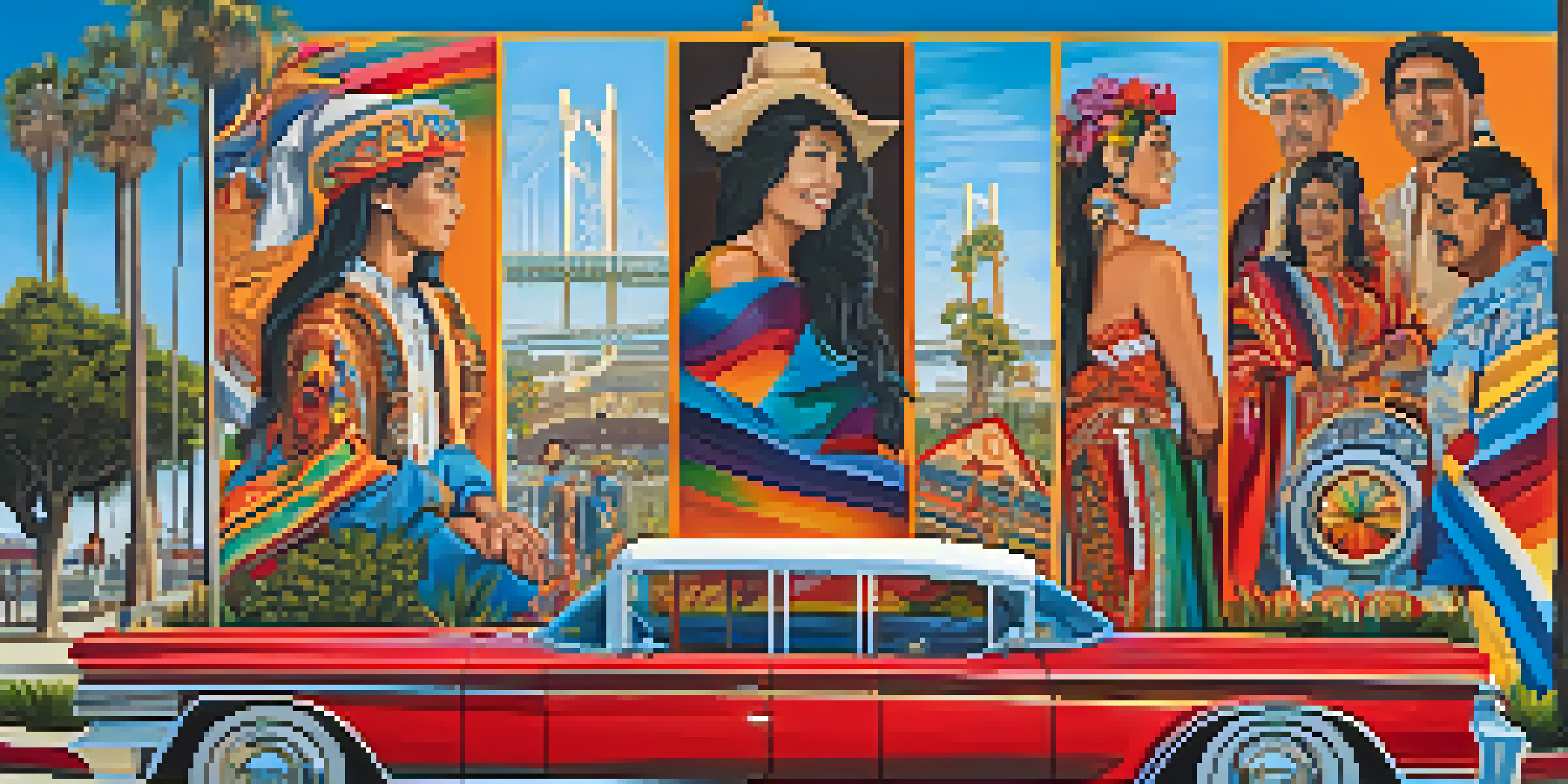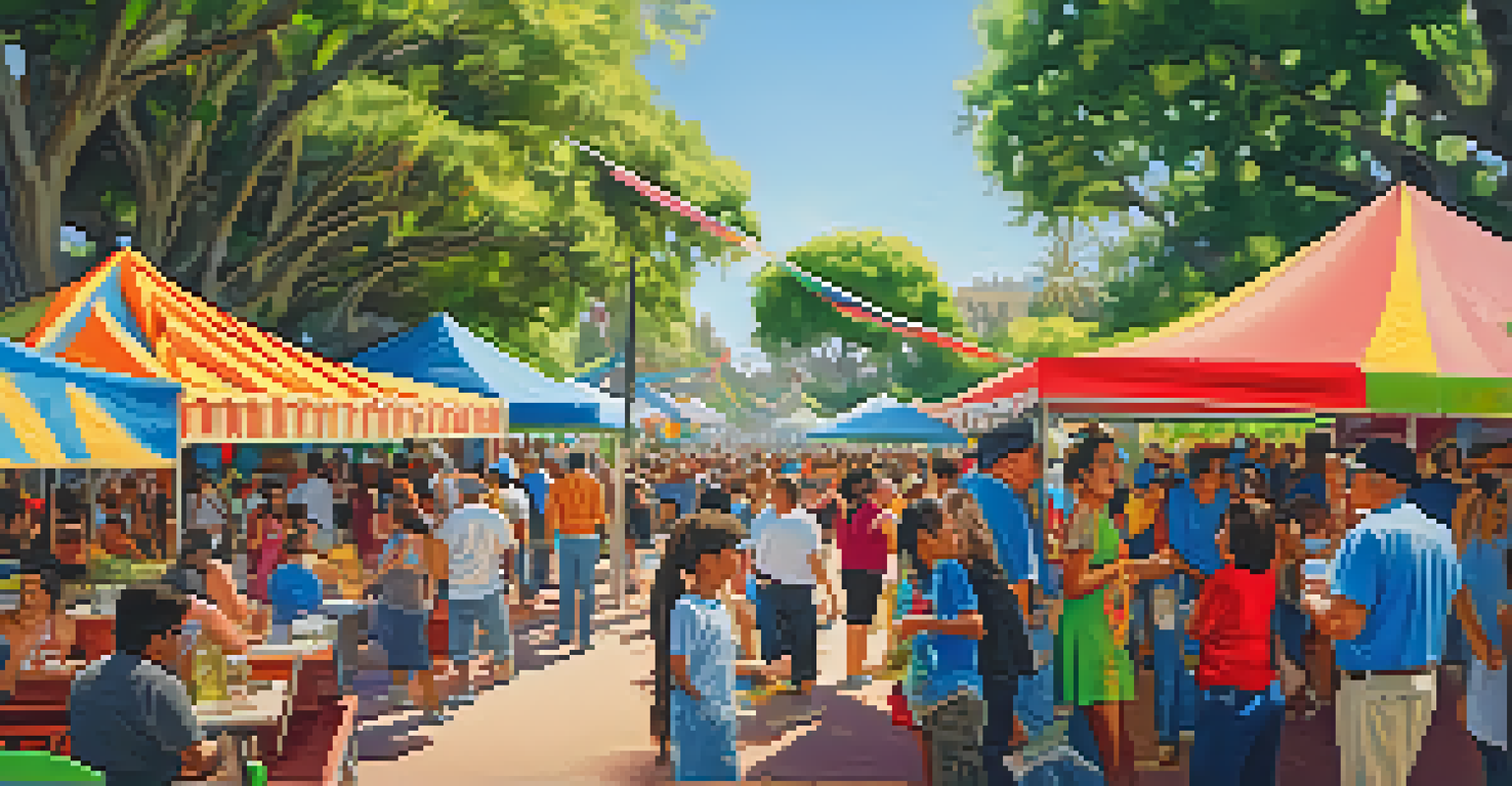The Role of Chicano Park in San Diego's Community Identity

The Historical Significance of Chicano Park
Chicano Park, located in the heart of San Diego's Barrio Logan, is a historical landmark that emerged from a grassroots movement in the 1970s. Initially a neglected space under the Coronado Bridge, it became a symbol of resistance and cultural pride for the Chicano community. The park's transformation reflects the struggles and aspirations of the local residents, marking an important chapter in San Diego's history.
Art is not what you see, but what you make others see.
The park's creation was driven by a community fight for land rights and cultural recognition, showcasing the determination of those who sought to reclaim their space. Activists rallied together to prevent the construction of a California Highway Patrol station, ultimately turning a potential setback into an opportunity for cultural expression. This historical backdrop adds depth to the park's significance, making it more than just a public space.
Today, Chicano Park stands as a testament to the power of community activism, serving as a reminder of the ongoing struggle for equity and representation. Its rich history invites visitors to learn about the cultural narratives that shaped the area, fostering a sense of connection and understanding among diverse communities.
Cultural Expression Through Murals
One of the most striking features of Chicano Park is its vibrant murals, which cover the park's walls and structures. These murals are not just art; they are powerful narratives that convey the experiences, struggles, and triumphs of the Chicano community. Each mural tells a story, offering visitors a glimpse into the rich cultural heritage and the ongoing journey toward social justice.

The murals serve as a canvas for local artists, many of whom are members of the community, allowing them to express their identities and perspectives. This creative outlet plays a crucial role in preserving cultural traditions, while also educating the public about the historical context of the Chicano experience. The colorful imagery transforms the park into an open-air gallery, inviting dialogue and reflection.
Chicano Park: A Symbol of Resilience
Chicano Park stands as a testament to the community's fight for land rights and cultural pride, reflecting their struggles and aspirations.
As people walk through Chicano Park, they are immersed in a visual storytelling experience that resonates on multiple levels. The art not only beautifies the space but also fosters a sense of pride and belonging among community members, reinforcing the idea that their voices and stories matter.
Chicano Park as a Community Gathering Space
Chicano Park serves as a vital gathering place for the local community, hosting numerous events throughout the year. From cultural festivals to music performances, the park brings people together in celebration of their heritage and shared values. These events create a sense of belonging and solidarity, reinforcing community ties that might otherwise fade in a fast-paced urban environment.
The greatest threat to our planet is the belief that someone else will save it.
The park's role as a communal space is particularly important for younger generations, who can connect with their roots and learn about their cultural history. Activities such as arts and crafts workshops, cultural dance performances, and educational programs foster intergenerational dialogue, helping to pass down traditions and stories. This nurturing environment allows for the continuity of cultural identity.
Moreover, Chicano Park acts as a platform for social activism, where community members can unite to advocate for various causes. Whether it’s environmental issues, housing rights, or education reform, the park provides a space for collective action, illustrating the community's resilience and commitment to creating positive change.
The Impact of Chicano Park on Local Identity
Chicano Park plays a crucial role in shaping the identity of San Diego's Barrio Logan, influencing how residents view themselves and their community. It stands as a symbol of pride, resilience, and cultural heritage, reinforcing a shared identity among its diverse inhabitants. This sense of belonging fosters a strong community spirit, allowing residents to celebrate their differences while uniting under common values.
The park's influence extends beyond its borders, impacting how the broader San Diego area perceives the Chicano community. Through its vibrant murals, cultural events, and community initiatives, Chicano Park helps to challenge stereotypes and misconceptions, promoting a deeper understanding of the complexities within the community. This dialogue is essential for fostering inclusivity and mutual respect among diverse populations.
Murals as Cultural Narratives
The vibrant murals in Chicano Park serve as powerful stories, expressing the experiences and identities of the Chicano community while fostering pride and education.
As a focal point of cultural identity, Chicano Park encourages residents to take pride in their heritage and advocate for their rights. This empowerment contributes to a stronger, more cohesive community that is better equipped to face challenges and celebrate achievements together.
Educational Opportunities at Chicano Park
Chicano Park serves as an informal educational space, offering visitors the chance to learn about the history and culture of the Chicano community. Guided tours, informational plaques, and community-led workshops provide valuable insights into the stories behind the murals and the significance of the park itself. This educational aspect enriches the experience for both locals and tourists, fostering a greater appreciation for cultural diversity.
Schools and educational institutions often organize field trips to Chicano Park, allowing students to engage with their cultural heritage in a meaningful way. These visits encourage young people to explore their roots and understand the importance of community activism and social justice. Such initiatives not only educate but also inspire the next generation of leaders and advocates.
Furthermore, the park's commitment to education extends to its cultural events, where attendees can participate in workshops and discussions that focus on various cultural topics. By promoting learning and understanding, Chicano Park plays an essential role in bridging cultural gaps and fostering dialogue among different communities.
Chicano Park: A Model for Urban Spaces
Chicano Park serves as a powerful model for how urban spaces can be transformed into cultural hubs that reflect the identities of local communities. Its success lies in the active participation of residents who took charge of their environment, demonstrating the potential for grassroots movements to effect positive change. This approach can inspire other neighborhoods seeking to enhance their own communal spaces.
The park's blend of art, culture, and community activism showcases how public spaces can be utilized to celebrate diversity and promote social cohesion. By prioritizing the needs and voices of the community, urban planners can create inclusive environments that foster connection and understanding among residents. Chicano Park is a shining example of what can be achieved when communities come together to reclaim and redefine their spaces.
Community Hub for Activism
Chicano Park functions as a vital gathering space for cultural events and social activism, reinforcing community ties and empowering residents to advocate for their rights.
Moreover, the park highlights the importance of preserving cultural heritage in urban development. As cities continue to grow and evolve, integrating cultural elements into public spaces can reinforce community identity and pride. Chicano Park's legacy serves as a reminder that urban spaces can be more than just functional; they can also be vibrant centers of culture and community.
The Future of Chicano Park and Community Identity
As San Diego continues to evolve, the future of Chicano Park remains a vital topic for discussion among community members. Ongoing efforts to preserve its cultural significance and ensure it remains a space for activism and celebration are paramount. Community leaders and residents are committed to maintaining the park's role as a focal point for cultural identity and social justice.
Looking ahead, there is a growing awareness of the need to engage younger generations in the park's legacy. Initiatives aimed at involving youth in decision-making processes and cultural programming will help ensure that Chicano Park remains relevant and meaningful. By fostering a sense of ownership among young people, the park can continue to thrive as a beacon of community pride.

Ultimately, Chicano Park is not just a physical space; it embodies the spirit and resilience of the Chicano community. Its future will depend on the collective efforts of community members to preserve and evolve its cultural heritage, ensuring that it remains a vibrant and integral part of San Diego's identity for generations to come.